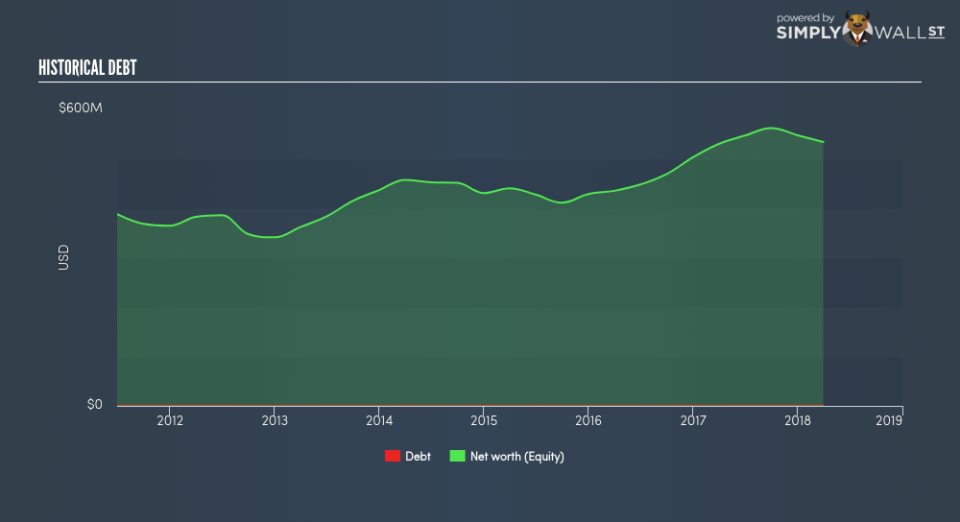Power Integrations Inc (NASDAQ:POWI): Can It Deliver A Superior ROE To The Industry?

The content of this article will benefit those of you who are starting to educate yourself about investing in the stock market and want to begin learning the link between Power Integrations Inc (NASDAQ:POWI)’s return fundamentals and stock market performance.
Power Integrations Inc (NASDAQ:POWI) delivered a less impressive 5.19% ROE over the past year, compared to the 13.83% return generated by its industry. Though POWI’s recent performance is underwhelming, it is useful to understand what ROE is made up of and how it should be interpreted. Knowing these components can change your views on POWI’s below-average returns. Metrics such as financial leverage can impact the level of ROE which in turn can affect the sustainability of POWI’s returns. Let me show you what I mean by this. View out our latest analysis for Power Integrations
What you must know about ROE
Return on Equity (ROE) is a measure of Power Integrations’s profit relative to its shareholders’ equity. It essentially shows how much the company can generate in earnings given the amount of equity it has raised. In most cases, a higher ROE is preferred; however, there are many other factors we must consider prior to making any investment decisions.
Return on Equity = Net Profit ÷ Shareholders Equity
ROE is assessed against cost of equity, which is measured using the Capital Asset Pricing Model (CAPM) – but let’s not dive into the details of that today. For now, let’s just look at the cost of equity number for Power Integrations, which is 9.90%. This means Power Integrations’s returns actually do not cover its own cost of equity, with a discrepancy of -4.71%. This isn’t sustainable as it implies, very simply, that the company pays more for its capital than what it generates in return. ROE can be split up into three useful ratios: net profit margin, asset turnover, and financial leverage. This is called the Dupont Formula:
Dupont Formula
ROE = profit margin × asset turnover × financial leverage
ROE = (annual net profit ÷ sales) × (sales ÷ assets) × (assets ÷ shareholders’ equity)
ROE = annual net profit ÷ shareholders’ equity
The first component is profit margin, which measures how much of sales is retained after the company pays for all its expenses. Asset turnover reveals how much revenue can be generated from Power Integrations’s asset base. Finally, financial leverage will be our main focus today. It shows how much of assets are funded by equity and can show how sustainable the company’s capital structure is. Since financial leverage can artificially inflate ROE, we need to look at how much debt Power Integrations currently has. Currently, Power Integrations has no debt which means its returns are driven purely by equity capital. This could explain why Power Integrations’s’ ROE is lower than its industry peers, most of which may have some degree of debt in its business.
Next Steps:
While ROE is a relatively simple calculation, it can be broken down into different ratios, each telling a different story about the strengths and weaknesses of a company. Power Integrations’s below-industry ROE is disappointing, furthermore, its returns were not even high enough to cover its own cost of equity. However, ROE is not likely to be inflated by excessive debt funding, giving shareholders more conviction in the sustainability of returns, which has headroom to increase further. ROE is a helpful signal, but it is definitely not sufficient on its own to make an investment decision.
For Power Integrations, there are three essential factors you should further research:
Financial Health: Does it have a healthy balance sheet? Take a look at our free balance sheet analysis with six simple checks on key factors like leverage and risk.
Valuation: What is Power Integrations worth today? Is the stock undervalued, even when its growth outlook is factored into its intrinsic value? The intrinsic value infographic in our free research report helps visualize whether Power Integrations is currently mispriced by the market.
Other High-Growth Alternatives : Are there other high-growth stocks you could be holding instead of Power Integrations? Explore our interactive list of stocks with large growth potential to get an idea of what else is out there you may be missing!
To help readers see pass the short term volatility of the financial market, we aim to bring you a long-term focused research analysis purely driven by fundamental data. Note that our analysis does not factor in the latest price sensitive company announcements.
The author is an independent contributor and at the time of publication had no position in the stocks mentioned.

 Yahoo Finance
Yahoo Finance 

